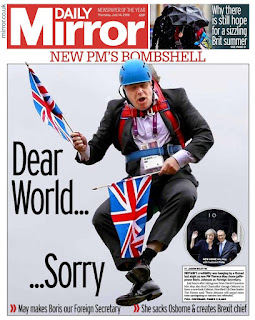The representations in this front page are of youth. This is from the outfit of the person on the front, he is wearing a tracksuit which is usually associated with young adults/ teenagers with lower classed backgrounds. It emphasises the idea that youth and people that wear tracksuits cause danger, suggested by the fire behind the person. Also, the figure in the article is covered up with gloves and a mask, which gives the idea all people the dress like that are the same and do similar things. The use of the word 'spread' goes with the image of the fire, as fire spreads quickly just like the riots.
In this article, the representation is of Britain. In the image is the Mayor of London Borris Johnson, who is not being presented in the best way. Britain is being represented by Borris, and as this image is quite comedic, it (in a way) embarrasses the public. The language used is an apology which emphasises the idea Britain may be ashamed. Also, there are little words and only a small body of text to the side which suggests there is not a lot of positive things to say about this article. The audience would be the British public who may find this either funny or humiliating.
Being represented in this article is Nelson Mandela. It is a stereotypical representation because his body language is strong and powerful, just like the way people know him for. The image is in black and white with no colours to show respect to Mandela. The use of the word 'Warrior' reflects how Mandela was seen as. Also, it is contrast with the phrase 'loses his final battle' as warriors are usually strong in battle but in this case, he died. The biggest text is 'Mandela Dead' which is not actually an actual sentence but is short and gets straight to the point. The Sun usually do this to main headlines.



No comments:
Post a Comment